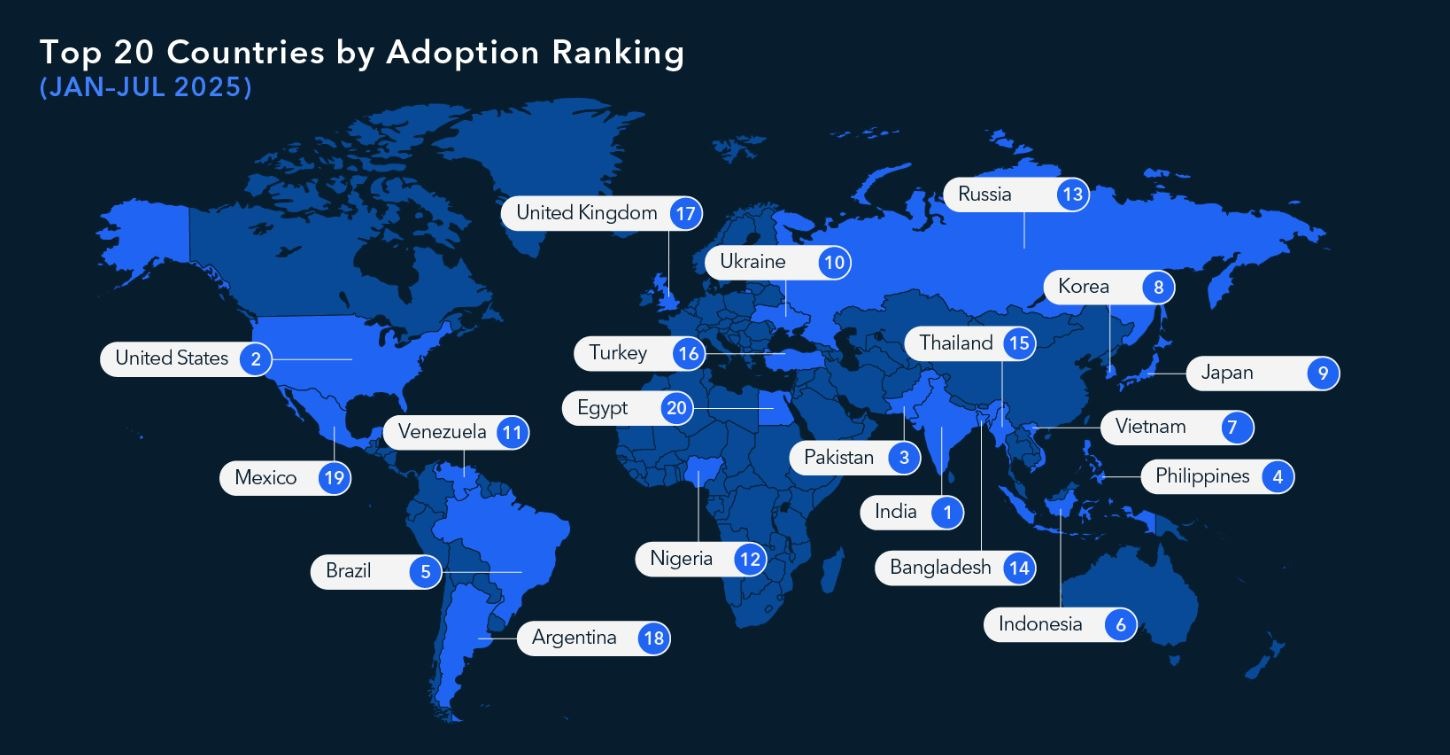Global retail crypto transactions surged by over 125% between January and September 2025, driven by improving regulatory clarity and practical use cases like payments and remittances. This marks the second consecutive year of such growth, highlighting crypto’s integration into everyday finance according to TRM Labs’ analysis.
-
Regulatory advancements in the US and Pakistan accelerated adoption, opening markets to new users.
-
Practical applications such as value preservation in volatile economies fueled most transaction volumes.
-
Despite bans in countries like Bangladesh, crypto uptake ranked 14th globally, with over 28 million projected users in Pakistan by 2026 per Statista estimates.
Discover how a 125% surge in global retail crypto transactions in 2025 reflects regulatory progress and real-world use. Explore key drivers and implications for mainstream adoption today.
What is Driving the Surge in Global Retail Crypto Transactions?
Global retail crypto transactions have experienced a remarkable 125% increase from January to September 2025, mirroring the growth observed in 2024, as reported by blockchain intelligence firm TRM Labs in its Crypto Adoption and Stablecoin Usage Report. This surge is primarily attributed to enhanced regulatory clarity worldwide, which has instilled confidence among retail users and expanded access to digital assets. Most of this activity revolves around practical applications, including payments, remittances, and safeguarding value amid economic instability, demonstrating how individuals are increasingly influencing the crypto ecosystem’s development.
As the crypto market matures, transaction patterns are diversifying with the involvement of structured service providers and institutional players. TRM Labs notes that this evolution underscores a shift toward broader financial inclusion, where retail participation is no longer fringe but central to the industry’s trajectory. The report emphasizes that political commitments and structural reforms have compounded these effects, particularly in key markets.
How Has Regulatory Clarity Impacted Crypto Adoption in Major Markets?
Regulatory clarity has been a pivotal factor in boosting global retail crypto transactions, especially in the United States, where growth initiated in 2023 and sustained through 2024 has accelerated further. TRM Labs highlights that a blend of political support, regulatory frameworks, and market-opening measures has welcomed new participants. For instance, significant legislative progress includes the GENIUS Act targeting stablecoins, the CLARITY Act for market structure, and collaborative task forces with the United Kingdom.
“The US market’s two consecutive years of double-digit expansion reflect not just enthusiasm, but the compounding effect of regulatory clarity and political commitment,” states the TRM Labs report. This environment has provided users with greater peace of mind, reducing uncertainties that previously deterred widespread adoption. In parallel, Pakistan’s crypto landscape has flourished due to supportive policies, including the establishment of the Pakistan Crypto Council and plans for a dedicated regulator, leading to soaring grassroots engagement.
Statista projects that Pakistan’s crypto user base could reach 28 million by 2026, representing over 10% of its 250 million population. Such developments illustrate a global pattern: in regions with proactive regulations, adoption surges rapidly, while even restrictive environments cannot fully suppress demand. TRM Labs observes, “In some jurisdictions, adoption has accelerated in response to regulatory clarity and institutional access; in others, it has expanded despite formal restrictions or outright bans.” This resilience points to crypto’s deepening roots in the financial mainstream, with stablecoins emerging as a cornerstone trend facilitating seamless cross-border activities.
The diversification of crypto’s footprint also reflects matured ecosystem dynamics. Retail users are leveraging cryptocurrencies for tangible benefits, such as cost-effective remittances and hedging against inflation. Data from TRM Labs indicates that these use cases accounted for the majority of transaction volume, underscoring a move away from speculative trading toward utility-driven engagement. Expert analyses, including those from the Financial Stability Board, reinforce that clear guidelines enhance market stability without stifling innovation.
Frequently Asked Questions
What Factors Contributed to the 125% Rise in Global Retail Crypto Transactions in 2025?
The 125% increase in global retail crypto transactions from January to September 2025 stems from regulatory advancements, political commitments, and practical applications like payments and remittances. TRM Labs’ report attributes this to market-opening reforms in the US and supportive policies in Pakistan, which have boosted user confidence and accessibility across diverse economies.
Why Is Crypto Adoption Growing Despite Bans in Countries Like Bangladesh?
Crypto adoption continues to rise in restricted environments like Bangladesh due to limited access to traditional finance and the appeal of digital assets for remittances and value preservation. Ranked 14th globally by TRM Labs, Bangladesh’s uptake persists amid central bank warnings since 2014, as individuals seek alternatives to capital controls and foreign exchange shortages, highlighting grassroots demand’s strength.
Key Takeaways
- Regulatory Clarity as a Catalyst: Progressive policies in the US and Pakistan have driven double-digit growth in retail transactions for two years, compounding market enthusiasm and institutional involvement.
- Practical Use Cases Dominate: Payments, remittances, and economic hedging represent the bulk of activity, signaling crypto’s shift toward real-world utility over speculation.
- Bans Fail to Deter Adoption: Countries like Bangladesh and North African nations show high rankings despite restrictions, as per TRM Labs, urging policymakers to consider alternatives to outright prohibitions for better financial inclusion.
Conclusion
The 125% surge in global retail crypto transactions in 2025, as detailed in TRM Labs’ Crypto Adoption and Stablecoin Usage Report, exemplifies how regulatory clarity and practical applications are propelling crypto into the financial mainstream. From US legislative strides like the GENIUS Act to Pakistan’s policy innovations, these developments foster inclusive growth even amid challenges in restricted markets. As stablecoins gain prominence and grassroots demand persists, the trajectory suggests sustained expansion, encouraging users and regulators alike to embrace this evolving landscape for enhanced economic resilience.
Most crypto activity over the last year has been tied to practical use cases such as payments, remittances, and preserving value in volatile economic conditions.
Improving crypto regulatory clarity has triggered a 125% surge in global retail crypto transactions for two years in a row, according to TRM Labs.
Worldwide retail crypto transactions rose by more than 125% between January and September 2025, echoing similar growth seen in 2024, according to the blockchain intelligence firm in its Crypto Adoption and Stablecoin Usage Report on Tuesday.
Most activity was tied to practical use cases such as payments, remittances, and preserving value in volatile economic conditions, showing individuals are playing an increasing role in shaping the industry’s evolution.
“As the ecosystem has matured, however, the footprint of crypto activity has diversified, with more structured service providers and institutional participants shaping transaction patterns.”
Crypto regulatory clarity giving peace of mind
In the US TRM Labs said the growth that began in 2023 and extended past 2024 has been reinforced and accelerated by a combination of political, regulatory, and structural factors, which have opened the market to new participants.
“The US market’s two consecutive years of double-digit expansion reflect not just enthusiasm, but the compounding effect of regulatory clarity and political commitment,” it wrote.
Since the start of the year the US has taken significant steps toward crypto regulations, with bills like the GENIUS Act aimed at stablecoins, the CLARITY Act, a market structure bill and its joint taskforce with the United Kingdom.
At the same time Pakistan’s crypto scene has also benefited from friendly lawmakers, TRM Labs said, with “soaring grassroots adoption,” further “buoyed by key policy moves,” such as the government establishing the Pakistan Crypto Council and announcing plans to develop a dedicated crypto regulator.
The number of crypto users in Pakistan is estimated to hit 28 million in 2026 by online data platform Statista, out of a population of 250 million.
“In some jurisdictions, adoption has accelerated in response to regulatory clarity and institutional access; in others, it has expanded despite formal restrictions or outright bans,” the firm said.
“These contrasting dynamics point to a consistent trajectory: crypto is moving further into the financial mainstream. A key trend underscoring this shift is the rise of stablecoins.”
Bans are ineffective and help adoption
The crypto uptake has also increased despite crackdowns on exchanges and capital controls in some countries, according to TRM Labs.
Bangladesh has no platforms licensed to operate legally in the country and since 2014 the country’s central bank, Bangladesh Bank, has issued warnings about crypto use.

Bangladesh’s government has taken a restrictive approach to crypto, but it’s still ranked 14th in the world for adoption. Source: TRM Labs
“However, ongoing capital controls and limited access to foreign exchange have made crypto an attractive option for individuals seeking alternatives to traditional financial systems,” TRM Labs said.
Related: Older, richer investors could power crypto adoption through 2100
A similar pattern is unfolding in several North African countries, such as Algeria, Egypt, Morocco, and Tunisia, where crypto is either banned or restricted; however, all four are ranked in the top 50 for worldwide adoption.
“Notably, the above jurisdictions outrank several countries with permissive or regulated frameworks — suggesting that grassroots demand for alternative financial tools can outweigh formal restrictions.”
A report issued by the Financial Stability Board, a global coordinator for financial rules and reforms, and the International Monetary Fund in September 2023, reached a similar conclusion: that blanket bans are ineffective and often increase incentives for people to use cryptocurrencies.
Magazine: Ether’s price to go ‘nuclear,’ Ripple seeks $1B XRP buy: Hodler’s Digest, Oct. 12 – 18
